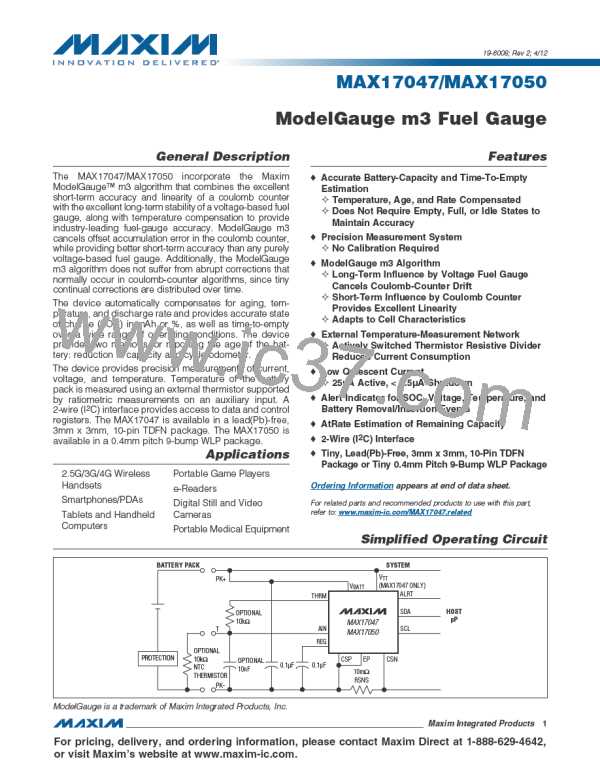MAX17047/MAX17050
ModelGauge m3 Fuel Gauge
Block Diagram
V
BATT
ALRT
IN
PK+
0.1µF
32kHz OSCILLATOR
ModelGauge m3
ALGORITHM
2V LDO
PK-
REG
OCV CALCULATION
OUT
CSP
V
TT
0.1µF
(MAX17047 ONLY)
PK+
PK-
MAX17047
MAX17050
P
REF
THRM
V
- V
/V
THRM DETR DETF
BATTERY
V
REMOVAL
BATT
DETECT
SDA
SCL
REF ADC
12-BIT ADC
2
AIN
I C
MUX
INTERFACE
10nF
CSP
CSN
10mI
RSNS
PK-
PK-
SYSTEM GROUND
pack is measured using an external thermistor supported
by ratiometric measurements on an auxiliary input. A
2-wire (I C) interface provides access to data and control
Detailed Description
2
The MAX17047/MAX17050 incorporate the Maxim
ModelGauge m3 algorithm that combines the excellent
short-term accuracy and linearity of a coulomb counter
with the excellent long-term stability of a voltage-based
fuel gauge, along with temperature compensation to pro-
vide industry-leading fuel-gauge accuracy. ModelGauge
m3 cancels offset accumulation error in the coulomb
counter, while providing better short-term accuracy than
any purely voltage-based fuel gauge. Additionally, the
ModelGauge m3 algorithm does not suffer from abrupt
corrections that normally occur in coulomb-counter algo-
rithms, since tiny continual corrections are distributed
over time.
registers. The MAX17047 is available in a 3mm x 3mm,
10-pin TDFN package. The MAX17050 is available in a
0.4mm pitch 9-bump WLP package.
ModelGauge m3 Algorithm
The ModelGauge m3 algorithm combines a high-accura-
cy coulomb counter with a voltage fuel gauge (VFG) as
represented in Figure 2.
Classical coulomb-counter-based fuel gauges have
excellent linearity and short-term performance. However,
they suffer from drift due to the accumulation of the offset
error in the current-sense measurement. Although the
offset error is often very small, it cannot be eliminated,
causes the reported capacity error to increase over
time, and requires periodic corrections. Corrections are
usually performed at full or empty. Some other systems
also use the relaxed battery voltage to perform correc-
tions. These systems determine the SOC based on the
battery voltage after a long time of no current flow. Both
have the same limitation: if the correction condition is not
The device automatically compensates for aging, tem-
perature, and discharge rate and provides accurate
state-of-charge (SOC) in mAh or % over a wide range of
operating conditions. The device provides two methods
for reporting the age of the battery: reduction in capacity
and cycle odometer.
The device provides precision measurements of current,
voltage, and temperature. Temperature of the battery
����������������������������������������������������������������� Maxim Integrated Products
8

 MAXIM [ MAXIM INTEGRATED PRODUCTS ]
MAXIM [ MAXIM INTEGRATED PRODUCTS ]